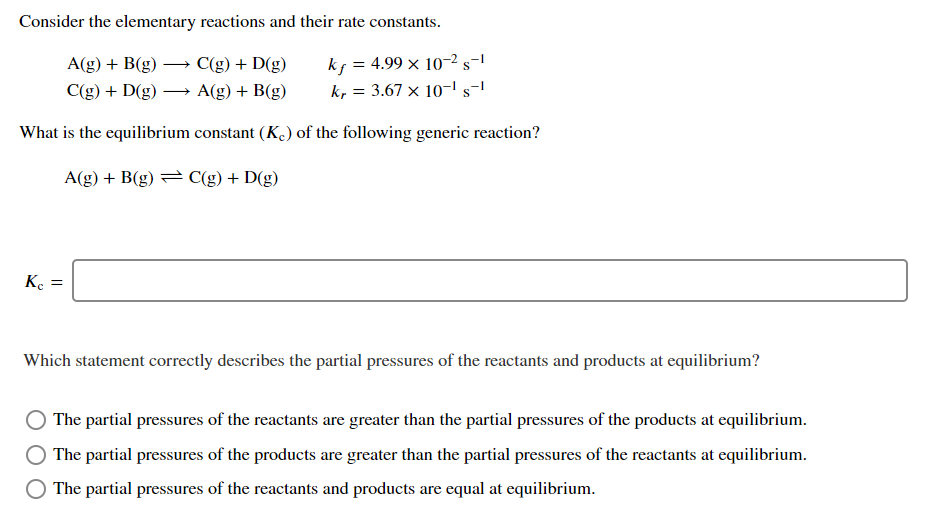Consider the elementary reactions and their rate constants. kg = 4.99 × 10-2 k, = 3.67 × 10-1s-1 A(g) + B(g) C(g) + D(g) C(g) + D(g) → A(g) + B(g) What is the equilibrium constant (K.) of the following generic reaction? A(g) + B(g) – C(g) + D(g) Ke Which statement correctly describes the partial pressures of the reactants and products at equilibrium? ||
Consider the elementary reactions and their rate constants. kg = 4.99 × 10-2 k, = 3.67 × 10-1s-1 A(g) + B(g) C(g) + D(g) C(g) + D(g) → A(g) + B(g) What is the equilibrium constant (K.) of the following generic reaction? A(g) + B(g) – C(g) + D(g) Ke Which statement correctly describes the partial pressures of the reactants and products at equilibrium? ||
Chemistry: The Molecular Science
5th Edition
ISBN:9781285199047
Author:John W. Moore, Conrad L. Stanitski
Publisher:John W. Moore, Conrad L. Stanitski
Chapter12: Chemical Equilibrium
Section: Chapter Questions
Problem 12QRT
Related questions
Question

Transcribed Image Text:Consider the elementary reactions and their rate constants.
kf = 4.99 × 10–2s-1
k, = 3.67 × 10-' s-'
A(g) + B(g) → C(g) + D(g)
C(g) + D(g)
A(g) + B(g)
What is the equilibrium constant (K) of the following generic reaction?
A(g) + B(g) = C(g) + D(g)
Ke =
Which statement correctly describes the partial pressures of the reactants and products at equilibrium?
The partial pressures of the reactants are greater than the partial pressures of the products at equilibrium.
The partial pressures of the products are greater than the partial pressures of the reactants at equilibrium.
The partial pressures of the reactants and products are equal at equilibrium.
Expert Solution
This question has been solved!
Explore an expertly crafted, step-by-step solution for a thorough understanding of key concepts.
This is a popular solution!
Trending now
This is a popular solution!
Step by step
Solved in 2 steps with 1 images

Knowledge Booster
Learn more about
Need a deep-dive on the concept behind this application? Look no further. Learn more about this topic, chemistry and related others by exploring similar questions and additional content below.Recommended textbooks for you

Chemistry: The Molecular Science
Chemistry
ISBN:
9781285199047
Author:
John W. Moore, Conrad L. Stanitski
Publisher:
Cengage Learning


Chemistry: An Atoms First Approach
Chemistry
ISBN:
9781305079243
Author:
Steven S. Zumdahl, Susan A. Zumdahl
Publisher:
Cengage Learning

Chemistry: The Molecular Science
Chemistry
ISBN:
9781285199047
Author:
John W. Moore, Conrad L. Stanitski
Publisher:
Cengage Learning


Chemistry: An Atoms First Approach
Chemistry
ISBN:
9781305079243
Author:
Steven S. Zumdahl, Susan A. Zumdahl
Publisher:
Cengage Learning

Chemistry
Chemistry
ISBN:
9781305957404
Author:
Steven S. Zumdahl, Susan A. Zumdahl, Donald J. DeCoste
Publisher:
Cengage Learning

Principles of Modern Chemistry
Chemistry
ISBN:
9781305079113
Author:
David W. Oxtoby, H. Pat Gillis, Laurie J. Butler
Publisher:
Cengage Learning

Chemistry for Engineering Students
Chemistry
ISBN:
9781337398909
Author:
Lawrence S. Brown, Tom Holme
Publisher:
Cengage Learning